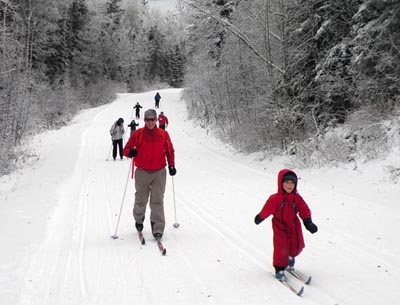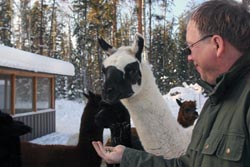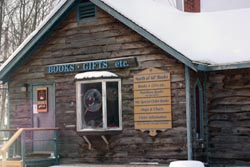BARB MARTOWSKI
 Fort Smith's Fitz-Smith Loppet, which takes place mid-March every year, is open to all ages. Courtesy WBNP |
FORT SMITH, NWT — Fort Smith, located just above the Alberta border in the Northwest Territories, is totally different from what I had expected. Than again, I didn't know what I expected, only that I was glad I could finally say, "I've been to the Northwest Territories."
What I found was a town that in many ways, reminded me of the artists' communities on the West Coast. People were welcoming and friendly, and they have a lot of pride when it comes to their town.
When I say artists' community, it's exactly that. Whether you're visiting the local book store, North of 60, where many of the local artists' display their work, taking a tour of the Northern Life Museum, hanging out with the alpacas at the Flat World Alpaca Farm or spending a few hours with world-renowned sculptor, Sonny MacDonald, it's crystal clear that many of the town's inhabitants are artists and artisans.
Alpacas vs. sheep
Out at the alpaca farm, owners Helena Katz and Mike Couvrette's herd of alpacas are guarded by a couple of gorgeous dogs and a slightly pushy llama. Katz and Couvrette raise the alpacas for their wool which is incredibly soft and warm.
"I only wear alpaca wool socks," said Couvrette, who is a regional programs director for Industry, Tourism & Investment with the Government of the Northwest Territories. "I find them much warmer than traditional sheep's wool and a lot less itchy."
"We comb and clean the wool ourselves and then we ship the wool to The Great Canadian Alpaca Company where it's knitted into socks, scarves, mitts – any number of items," said Katz. "They send us back the finished products which we sell."
Given that both Couvrette and Katz have busy careers (she's a writer), it's a sound business strategy which let's them raise the animals that they both have a passion for, and at the same time, pay for their feed and upkeep through the sale of the finished products. If you like to knit and find yourself in Fort Smith, make sure to drop in and buy some of the wool. You might find yourself with a new favourite knitting material.
 Mike Couvrette, owner of the Flat World Alpaca Farm in Fort Smith, NWT, gives treats to his alpacas and the big boy llama. BARB MARTOWSKI/SnowSeekers |
Back in town at the museum, there was more evidence that this community has a long association with art and culture.
Down through the ages
Outside, Kevin Brunt, the Curator of Collections and a volunteer crew have been working hard to create a First Nations' village complete with drying frames, food storage facilities as well a teepee. Inside, it was also somewhat of a construction zone as a few displays were being dismantled to make way for new exhibits.
"We're planning to have our outside exhibit completed by this summer," said Brunt, as he and I looked at a partially built river life display. "This particular display, when it's finished, will show the eco-system of the Slave River."
It's in keeping with a lot of what the museum is all about. It's as much a naturalist museum as it is a history-of-the-peoples museum with the focus right on the Fort Smith area. Two particular displays really show the artists behind the displays, the Canus Whooping Crane and the bison. Like the soon-to-be Slave River eco-system, the backgrounds are as visually appealing as the foreground creatures and showcase the talent and understanding the artists have for their subjects.
This understanding of subject and medium is also evident in the works displayed at the North of 60 bookstore. Whether it's semi-precious stones and metals, birch bark, leather, wood or glass, each piece was created with care and attention to detail. While the rest of my crew were enjoying perusing the bookshelves or trying to decide what to take home as a gift, I kept walking back to an Inukshuk carved out of antler.
The outdoors plays a big role
In the end, it had to come home with me. At the counter, I met Gord Rothnie and he and I fell into talking about the outdoor activities that are available in Fort Smith.
"Snowmobiling and ice fishing are big around here," said Rothnie, who works with the youth in the community, "but also snowshoeing and cross-country skiing. During the winter, we have a number of festivals and events especially in March. There's the Fitz-Smith Loppet which takes place in mid-March around the same time as our Wood Buffalo Winter Frolics.
"We also have a big fishing derby that draws a lot of people – it's taking place this year Mar. 19 to 21. Of course there's also the Northern Lights. Fort Smith is a great place to see them, whether you go out to the landing (at Riverbank Park) or you're just walking down the street, if you look up, you will probably see them."
 The North of 60 Bookstore sells books plus a large selection of local artists' and artisans' work. BARB MARTOWSKI/SnowSeekers |
But Rothnie admitted that he wasn't much of a winter person. "I prefer the summer. I'm a paddler and I much prefer running the rapids on the Slave River. But you know, Fort Smith is a great place to visit anytime of the year. You should think about coming back for the August long weekend – the Paddle Fest is on then and the rapids are pretty spectacular."
Being a paddler myself, I just might have to, but as for seeing the Aurora Borealis just by looking up, it just didn't happen on this trip. From the time we landed in Fort McMurray to start our trek up the Winter Road, to when we boarded the plane in Fort Smith to come back to Edmonton, we had nothing but overcast conditions and serious wind during our world-wind tour to the north.
Planning your trip
When it comes to accommodations, there are three B&Bs – the Axe Handle Guest House, Thebacha Bed and Breakfast and the Whispering Pines Cottages plus a number of fishing and outfitting lodges in the area. We stayed at the one and only hotel in town, the Pelican Rapids Inn, a 31-room hotel that offers a number of amenities including jacuzzis, satellite TV, a lounge and a restaurant. It's a comfortable place with superb service and friendly staff, especially in the restaurant where the menu offerings include Chinese, Thai and Italian as well as Canadian cuisine.
Unlike Fort Chipewyan, Fort Smith is not dependent on the Winter Road for access. You can reach it driving via the Mackenzie Highway from Edmonton, Alberta, the Alaska Highway through the Yukon or the Liard Highway in British Columbia.
Alternately, if you are looking to get there in a hurry, consider flying in. There's regional flights from both Edmonton and Calgary, Alberta, and during the winter, from Vancouver, British Columbia. Connector flights are also available from Yellowknife, NWT.
For more information on Fort Smith visit www.spectacularnwt.com or the Wood Buffalo National Park website.
For the latest deals, snow reports and contests, sign up today to our SnowSeekers e-newsletter.